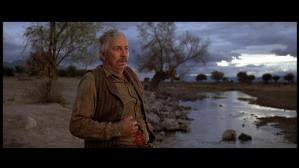This Andrew Wyeth painting is an all-time favorite of mine. I love the ambiguity of the girl's pose towards the foreboding house on the hilltop. There may be something creepy going on or not. It all depends on what's going on in the girl's head and in the house. Whatever the case, at this point in time she appears safe and unaware. Apparently, Philip Ridley is also a fan of the painting as he visually made it come to life in his 1990 film The Reflecting Skin. The story concerns a young boy, named Seth Dove, who lives and plays amongst the rural wheat fields of Idaho in the post WWII era. It's a coming of age tale of sorts, but of a vastly different variety than the Saturday Evening Post-type to which American audiences have grown accustomed to over the years. All the archetypes are present, from the beautiful rural settings, to the young frolicking playmates, to the quaint country farmhouses. Indeed the first line of dialogue Seth delivers to his friends, "Look at this wonderful frog I've found", serves only to reinforce the Norman Rockwell-ish environment Ridley creates in the opening scene. It is all then subverted by the use to which the kids subsequently put said frog. This horrific scene literally blows up any notion of sweet, well-behaved boys spending lazy summer days down by the fishin' hole.
Seth is subsequently punished for his cruel frog shenanigans by his none too stable mother by being sent to the house of his victim, an English widow named Dolphin Blue. Instead of being upset, Dolphin relates to Seth stories of her own acts of animal tortures when she was his age and gives him her family's whaling harpoon. She also tells him the story of her husband's demise which begins to sow the seeds in Seth's mind that she's a vampire. This is later unintentionally confirmed by Seth's father and his vampire comic book. Seth's obsession with the woman only intensifies when his older brother Cameron comes home from the military and begins a relationship with Dolphin Blue.
In a more conventional film, Seth and Dolphin's relationship would end in some tragic misunderstanding, and the table is certainly set for that, but the movie is anything but predictable. With a variety of odd people populating the locale and an apparent killer on the loose, things just keep getting stranger. In addition, many of the characters in the story seem to live up inside their own heads creating their own warped version of the world and ignoring events around them that contradict their notions until reality comes crashing down on them. Seth and his mother are the prime examples, but there are also minor characters like the weird, keening twin sisters with the dead bird who are clearly traveling their own path so to speak. The odd characters, deaths and all-American setting would certainly suggest something Lynchian but the film isn't as frustratingly opaque or convoluted as a David Lynch film even if it does feel as absurd at times. The Sheriff Ticker character, for example, seems to have a problem with the indigenous wildlife, losing an arm, eye and part of an ear to various creatures over the years. And I don't even want to bring up the dead "angel" that Seth and his friend find to show just how downright bizarre the film becomes.
But all the weirdness doesn't ultimately distract from the message of the film about loss of innocence. Towards the end, Dolphin tells Seth "innocence can be hell" but what she doesn't tell him, and what she knows, is that lack of innocence is hell. Seth's ability to stay in his fantasy world ironically keeps him from being pummeled by reality. And as much as the adults in the story want to build their own constructs to escape the real world, they're inevitable forced to face its harsh unfairness sooner rather than later. Like the ambiguity in the Wyeth painting, innocence appears to be only a temporary state, but it's still preferable to the alternative.
Score 8.5/10


















